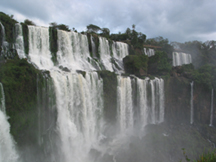 Lists
of interesting places to visit have become something of a cottage industry.
1000 Places to See Before You Die (Patricia Schultz, Workman Publishing,
2003) and its tie-in materials of travel journals and calendars are bestsellers.
Similar books include Unforgettable Places to See Before You Die (Steve
Davey and Marc Schlossman, Firefly Books, 2004) and Unforgettable Things
to Do Before You Die (Steve Watkins and Clare Jones, Firefly Books, 2005).
Lists
of interesting places to visit have become something of a cottage industry.
1000 Places to See Before You Die (Patricia Schultz, Workman Publishing,
2003) and its tie-in materials of travel journals and calendars are bestsellers.
Similar books include Unforgettable Places to See Before You Die (Steve
Davey and Marc Schlossman, Firefly Books, 2004) and Unforgettable Things
to Do Before You Die (Steve Watkins and Clare Jones, Firefly Books, 2005).Iguazú Falls, called Foz do Iguaçu in Portuguese, and Cataratas del Iguazú in Spanish, lie on the Brazil-Argentina border and are a must-visit for any geology enthusiast. Courtesy of Lisa Rossbacher.
After having written more than 100 columns in Geotimes, I am well aware that the one column of mine that continues to generate the most correspondence (as recently as a few months ago!) was about the “geologist’s life list.” The column was first published in the April 1990 issue and reprinted in December 1998. The concept follows the “life lists” that many avid birdwatchers keep, tracking locations and experiences of geological significance.
My original geologist’s life list was influenced heavily by places I had visited or read about, and by the travels and opinions of friends and family, with some effort to include geologic and geographic diversity. The initial list created a storm of suggestions for additions, and an addendum was published in Geotimes a year later, in April 1991.
Looking back on the lists from a distance of 15 years, they’re not bad. There are some places I would absolutely add (Iguazú Falls, in Argentina and Brazil, for example) and some that I might leave out (the Carolina Bays can be, well, sort of underwhelming). But overall, I included most of the biggies.
In 1996, Terry Acomb, then a graduate student at the University of Cincinnati, turned the idea of a geologist’s life list into a creative Web site that includes both the original lists and some of his own favorite locales. Although Acomb has long since graduated from the University of Cincinnati, the geology department there continues to host the site — and I am grateful for that support.
The geologist’s life lists beg an inevitable comparison with the 1000 Places book. Just as my geological colleagues had opinions about my lists, so do I have opinions about the 1000 Places list. The overlap between the original geologist’s life lists and the 1,000 places is limited. Several reasons explain this difference.
Some of the items on the geologist’s life list are generic, such as “a desert, both erg and reg” (“sand sea” and pavement) and “coastlines along the leading and trailing edge of a tectonic plate,” and therefore they cannot be correlated to the specific locations in 1000 Places. Some of the items on the life list are experiential and not location-specific: “feel an earthquake with a Richter magnitude greater than 5.0” and “find gold, however small the flake.” Still others are, I admit, not likely to interest a nongeologist; visiting an ophiolite or an anorthosite complex is not part of most tourist guides. And the 1000 Places has a major emphasis on hotels and restaurants, rather than rocks.
Nevertheless, the lists do have some similarities. In 1000 Places, 17 spots were specifically mentioned on one of the two original geologist’s life lists published in Geotimes:

